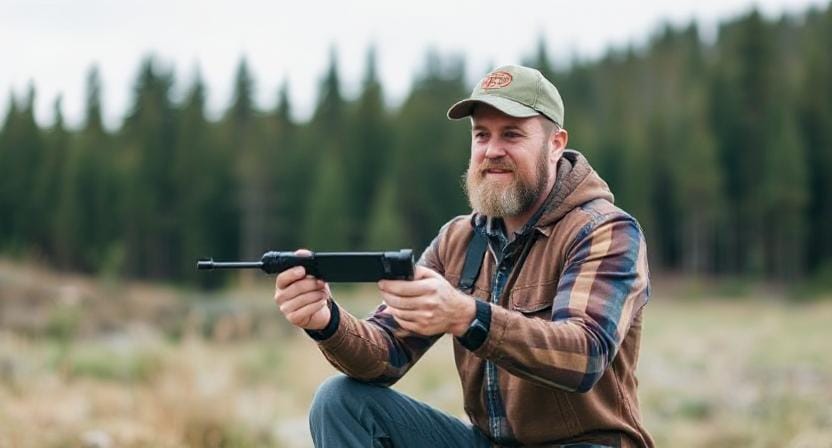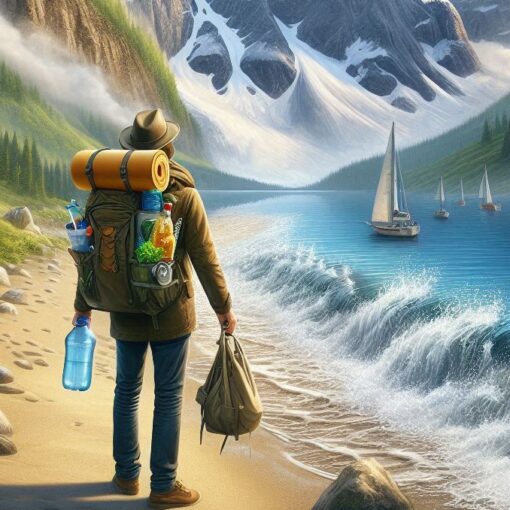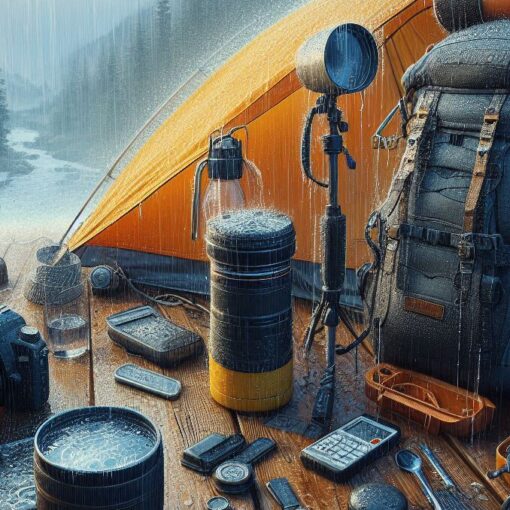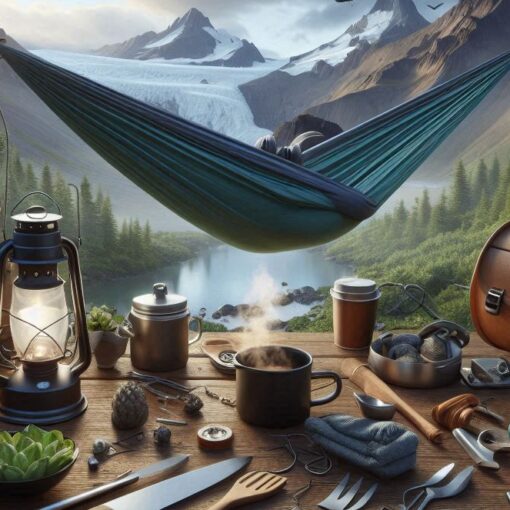Please Note: This post may contain affiliate links. If you click one of them, we may receive a commission at no extra cost to you. As an Amazon Associate, I earn from qualifying purchases.
Top Takeaways and Key Concepts
→ Plan before heading outdoors to avoid risks like getting lost, injured, or sunburned during your adventure.
→ Start with shorter trails and manageable elevations to build endurance and confidence safely over time.
→ Protect yourself from the sun by using SPF sunscreen, reapplying often, and wearing UV-rated clothing.
→ Pack smart gear essentials like helmets, first-aid kits, hydration, and tools for hiking, biking, or climbing.
→ Follow outdoor etiquette and safety rules to respect wildlife, other adventurers, and the natural environment.
Summary of This Article
This article delivers a lively, practical guide for anyone stepping back into the wild. It emphasizes preparation, smart trail selection, and protection from the elements while covering must-have safety gear for activities like hiking, biking, and climbing. Readers learn how to balance adventure with caution—packing the right tools, following outdoor etiquette, and respecting nature’s unpredictability. The message is clear: with preparation, awareness, and a good dose of humor, every trip outdoors can be safe, memorable, and full of adventure.
Short Video Version of this Article
Do you feel like you’ve been stuck inside for too long? I absolutely understand that. It’s like being in a room with too many people who talk too much. Want to take a break? Nature is beckoning, and it sounds great! Just a heads up: Mother Nature doesn’t care if you neglected to bring extra food or sunscreen.
If you don’t plan beforehand, your fantastic day outside could turn into one of those “Lost in the Wilderness” movies. You know, like when the main character thinks they can just make it up as they go along? Spoiler alert: they always feel bad about it.
Before you grab your backpack and go, let’s talk about some important outdoor skills. They are quite useful. You will be glad you did when you aren’t disoriented, sunburned, or nursing a sore butt from a bumpy bike ride.

Make a list to start. It really helps. You might want to bring water, snacks, a map, and maybe even a friend. You can’t eat stones, can you? Those extra granola bars could rescue the day. And don’t forget your favorite hat and some sunscreen. Believe me, or you’ll look like a lobster.
Knowing how to get around can save your life. Get a map or download a hiking app. You might think, “I’ll just follow my nose,” but it could take you to… well, not much fun.
Be alert of what’s going on around you when you’re on the trails. Keep an eye on where you’re going while you enjoy the birds and trees. If you can, tell someone what you’re going to do. That way, your friends won’t have to look for you all over the place if you don’t come back. It makes me laugh just to think about it.
Get ready for your trip outside! You can have a terrific day with just a little bit of planning. Take in the views, breathe in the fresh air, and maybe even snap a few pictures. There is so much to do in nature, and you’ll have a great day, with or without bees!
How to Choose the Right Hiking Trail: Avoiding the Trails of Tears

Ah, the open trail! So exciting, right? But wait—how do you even pick the right one? Do you go by distance, elevation, or just choose the one that sounds a little less scary?
Here’s a pro tip: start small. If 8 miles feels like a mountain, then trekking it will be like walking through a movie called “Tough Times.” Instead, grab a 5-mile trail and work your way up. Baby steps are key.
Elevation changes can be tricky. They slow you down more than your grandma’s old Buick from the ’80s. If you see a 10% grade, get ready for some serious calf burn. It’s like your legs are saying, “Why are we doing this?” So, listen to them.
If you’re just getting started, stick to out-and-back trails. It’s way easier. No need to overcomplicate things with loops. You wanna keep it simple, right? You’ll be glad when you can just turn around and head back instead of wandering into a mystery land.
Think about what you enjoy. Do you want to see pretty views? Or maybe a nice river? Check some maps and see what’s out there.
And there’s no shame in bringing a friend along. They can help distract you when the trail gets tough. Plus, they might have snacks. Who doesn’t love snacks?
So lace up those shoes, grab that water bottle, and hit the trail. You got this! Just remember, every hike is an adventure, even if it’s just a short one. Enjoy the fresh air and have fun!
Sun Protection: Because Lobster Red is Not a Good Look
It’s summer, you’re outdoors, and the sun is shining. Cue the sunscreen! And no, clouds don’t save you—they’re just playing a cruel joke. Whether it’s bright and sunny or suspiciously overcast, slather on that SPF like your life depends on it (because it kind of does).
Oh, and reapply every 90 minutes to two hours. Seriously, unless you’re going for the “I resemble a tomato” look, keep that sunscreen handy. And if you’re spending hours outside, consider investing in SPF-rated clothing. It’s like having armor against UV rays, only way more stylish.
Sizing Up Your Bike: Bigger Isn’t Always Better
So, you’ve decided to hit the trails on a bike—great choice! But here’s the thing: if your bike doesn’t fit, you’re in for a world of discomfort. And trust me, walking your bike up a hill while everyone else zips by is not a good time.
The key is finding the right size, and this isn’t a one-size-fits-all situation. Head to a bike shop and get fitted properly. And if you’re between sizes, don’t panic—there’s a thing called “extra medium.” It’s not a joke; it’s a real size. Once you’ve got the right fit, you’re golden.
What to Pack for Biking: Your Bike’s Emergency Kit
Now that you’ve got your bike, let’s talk gear. Helmets are non-negotiable—your brain is important, so protect it. Look for a helmet with MIPS technology, which sounds fancy because it is. It’s the best thing since sliced bread when it comes to helmet safety.
Besides that, pack a mini pump, spare tube, and a bike multi-tool. Knowing how to use these is crucial unless you want to be that person flagging down help because your tire went flat two miles from civilization. Take a bike maintenance class if you’re new to this—being self-sufficient is way cooler than you think.
First-Aid Kits: Not Just for Boy Scouts
Let’s get real: hiking is all fun and games until someone gets a blister. Or worse. That’s why a first-aid kit is a must. Think of it as your lifeline, not just for yourself but for anyone else who might need it.
Keep your kit organized, with the most-used items on top—no one wants to dig through gauze when you need a bandage stat. A compact, well-organized kit will save the day more times than you might think. And who knows? You might just be someone’s hero on the trail.
Hiking Poles: Not Just for the Old Folks
You’ve probably seen hikers with poles and thought, “Do I really need those?” Well, unless you enjoy falling flat on your face or putting extra pressure on your knees, the answer is yes.
Hiking poles are your best friends on uneven terrain. They help with balance and reduce the strain on your joints. The trick is to get the right size—aim for a 90-degree bend in your elbow when the pole is on the ground. And if the trail gets steep, don’t be afraid to adjust the length. Trust me, your knees will thank you later.
Paddleboarding: The Art of Not Falling
Paddleboarding looks serene, right? It is, once you figure out how to stand up without face-planting into the water. The trick is to start on your knees and get a feel for the board.
Once you’re comfortable, stand up while you’ve got a bit of momentum going. It’s easier than trying to balance while stationary. Once you’re up, practice the “step-back” turn—it’s a skill that’ll make you look like you know what you’re doing, even if you don’t.
Bear Encounters: Staying Out of the Menu
If you’re hiking in bear country, you need to know what to do when you run into one. For black bears, stay calm, back away slowly, and give them space—like 10 to 15 minutes of space.
For grizzlies, things get a bit more intense. Make noise as you hike to avoid surprising them, and keep your bear spray ready. Running is a no-go, unless you want to be the main course. Stand your ground, use the spray if necessary, and remember: bears aren’t interested in you unless you give them a reason to be.
Climbing Harnesses: Finding Your Perfect Fit
Planning to try rock climbing? First things first—get a harness that fits right. You don’t want to be dangling from a cliff in something that’s too loose or too tight.
Most outdoor stores can help you find the right fit, so take advantage of that expertise. And don’t skimp on features if you’re serious about climbing. Extra padding, gear loops, and adjustable straps are worth the investment.
Bike Soreness: Avoiding the Pain in the Butt (Literally)
Cycling is fun until you’re dealing with a sore butt and groin. Yes, it’s a thing. To avoid this, invest in a good pair of chamois shorts—they’re like cushions for your nether regions. And no, don’t wear underwear with them; it defeats the purpose. If you’re still sore, try a breathable liner or take more breaks. Chafing cream can also work wonders. Your backside will appreciate the extra effort, trust me.
Trail Etiquette: Don’t Be That Guy
Think hiking is just walking on dirt? Think again. There’s a whole set of unspoken rules out there. The big one: yield to horses. They’re bigger than you and could crush you without breaking a sweat.
Mountain bikers should yield to hikers, and everyone should step aside for uphill travelers. Of course, not everyone follows these rules, but it’s good to know them. And always, always let others know how many people are in your group when passing—it’s just good manners.
Hiking Footwear: Because Blisters are the Worst
You don’t need special shoes for every hike, but if you’re planning something more than a walk in the park, consider investing in hiking footwear. Look for shoes with good grip and ankle support. Waterproof shoes are great for wet conditions but can make your feet sweat in dry climates. Choose what’s best for where you’re hiking, and make sure to break them in before hitting the trail. Blisters are a quick way to ruin any adventure.
Night Sky Photography: Because the Stars Won’t Wait
Camping under the stars? It’s the perfect time to capture some night sky photos. But here’s the catch—you’ll need an SLR camera and a tripod, or you’ll end up with a blurry mess. Set up before it gets dark so you can practice with your camera settings.
And remember, you’ll need long exposures to capture those stars. Patience is key, but the results will be worth it. Plus, you’ll have some epic photos to show off when you get back.
Dressing for a Hike: Function Over Fashion
Good news—you probably don’t need to go on a shopping spree to get hiking-ready. Quick-drying fabrics are your best friend, so dig through your closet for synthetic materials or Merino wool. Skip the cotton; it’s like a sponge and will leave you soaked.
For longer hikes, consider investing in a hydration pack—it’s like having a personal water fountain strapped to your back. Trust me, staying hydrated without having to fumble for a bottle is a game-changer.
Okay, here is a short handbook to surviving in the wild. Just enough to protect you from being one of those stories that people tell at dinner to warn them. These methods can truly help you whether you’re climbing high mountains, walking through thick forests, or just attempting to make your way back to the car without needing a rescue squad.
Nature is a lot of fun! It’s not simply about finishing the trail. Have fun on the trip. Don’t rush. Look up at the sky and smell the flowers. Just don’t forget to pack well. And don’t forget the sunscreen! Skin that is peeling is never a good look.
Now go on your way, adventure-seeker! Have faith in yourself and dive into those wonderful outdoors. You could even make it funny. Trust me, a well-packed bag makes a big difference.
Don’t worry if you ever find yourself in a tough spot. Duct tape is a great help. All you have to do is be creative to mend things. The forest is like a huge playground, and if you know how to do it, you’ll be swinging from the trees in no time.
So, have a good trip! Enjoy every second and have fun! You can do this!
Featured Snippet: Outdoor adventures are safer and more enjoyable when you plan ahead, choose the right gear, and protect yourself from the elements. Preparation, awareness, and good trail etiquette ensure every trip is fun, comfortable, and stress-free, whether hiking, biking, or exploring the wild.
Frequently Asked Questions
What should I do before heading out on an outdoor adventure?
Plan ahead by researching your location, checking the weather, and packing essentials like water, snacks, sunscreen, and a map. Proper preparation prevents stress and ensures safety.
How can beginners choose the right hiking trail?
Start with shorter, low-elevation trails to build stamina. Look for out-and-back routes with scenic views to make the experience enjoyable and easier to navigate.
What are the most important safety essentials for outdoor trips?
Always carry a first-aid kit, navigation tools, hydration, weather-appropriate clothing, and protective gear such as helmets or sturdy footwear.
How can I protect my skin from the sun while outdoors?
Apply broad-spectrum SPF sunscreen regularly, wear UV-rated clothing, and use hats or sunglasses for extra protection—even on cloudy days.
Why is proper gear fit important for activities like hiking or biking?
Ill-fitting gear causes discomfort and fatigue. Ensure your backpack, shoes, or bike fit correctly to improve performance and prevent injuries.
What is proper trail etiquette for outdoor explorers?
Yield to uphill travelers and horses, keep noise low, avoid littering, and respect wildlife. Following these rules keeps trails safe and enjoyable for everyone.
How can I stay safe around wildlife during hikes?
Keep a safe distance, make noise to avoid surprise encounters, and never feed animals. In bear country, carry bear spray and know how to use it.

Kevin Collier is a seasoned outdoor enthusiast and writer for Trekbug.com, specializing in outdoor adventures, survival strategies, and prepping insights. With a deep love for nature and a commitment to self-sufficiency, Kevin empowers readers to embrace the wilderness confidently. He shares valuable tips, practical techniques, and inspiring stories, helping both novice and experienced adventurers develop essential skills for surviving and thriving in the great outdoors.




